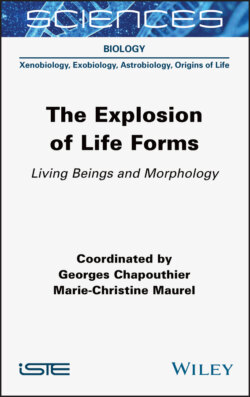Читать книгу The Explosion of Life Forms - Группа авторов - Страница 2
Table of Contents
Оглавление1 Cover
2 Title Page
3 Copyright
4 Introduction
5 1 Possible Traces and Clues of Early Life Forms 1.1. Introduction 1.2. Have “things” always been as they are today? 1.3. Fossil traces? 1.4. Geochemical elements confirming these recent results 1.5. Compartmentalization of resources and primary biomass 1.6. Rebuilding a living cell: a wide range of possibilities explored, from the mineral to the organic 1.7. Conclusion 1.8. Acknowledgments 1.9. References
6 2 The Nature of Life 2.1. Observations and assumptions 2.2. Descriptions and definitions 2.3. Exploration 2.4. Conclusion 2.5. References
7 3 From Form to Function 3.1. Form: a concept for knowledge 3.2. Basic structural elements: from the molecule to the cell 3.3. The weight of the physical setting 3.4. Mesoderm: base material for architect genes 3.5. Appendices and laws of mechanics 3.6. “Appendicular” movement on land 3.7. The legless 3.8. And the head 3.9. References
8 4 On Growth and Form: Context and Purpose 4.1. D’Arcy Thompson’s program 4.2. Application of mathematics to morphometry 4.3. References
9 5 The Emergence of Form in the History of Epigenetics 5.1. Introduction 5.2. From epigenesis to epigenetics 5.3. The evolution of the epigenetic landscape 5.4. Modernizing the epigenetic landscape 5.5. From epigenetic landscape to chromosome conformation 5.6. Conclusion: from form to function 5.7. Acknowledgments 5.8. References
10 6 The Many Shapes of Microbial Detection of Kin and Kind 6.1. From Darwin’s social-insects-puzzle to microbes 6.2. Handshakes of kinship or “kindship” in bacteria 6.3. The ameba world of clone discrimination/recognition 6.4. social microbes and multicellularity 6.5. Conclusion 6.6. References
11 7 Development and Evolution of Plant Forms 7.1. Introduction 7.2. Diversity of plant forms and associated functions 7.3. Origin and evolution of plant forms 7.4. Origin and evolution of plant forms 7.5. Conclusion 7.6. Acknowledgements 7.7. References
12 8 Forms of Memory 8.1. Introduction 8.2. The polymorphism of memory 8.3. Non-associative memories 8.4. Classical conditioning 8.5. Instrumental conditioning 8.6. Procedural memory as a “memory system” 8.7. Declarative memory 8.8. Short-term memory and working memory 8.9. Conclusion: organization and reconfiguration of the different forms of memory 8.10. References
13 9 The Construction of Sensory Universes 9.1. Introduction 9.2. Chemoreception 9.3. Mechanoreception 9.4. Electromagnetoreception 9.5. Information filtering 9.6. Conclusion 9.7. References
14 10 Emotional and Social Forms of Robots 10.1. Introduction 10.2. Communication with social and emotional robots 10.3. Human empathy for machines 10.4. Machine emotions 10.5. Conclusion: risks and benefits 10.6. References
15 11 When Medical Technology Mimics Living Forms 11.1. Introduction 11.2. Historical and epistemological perspective 11.3. Simulation, biomimetics and bioprinting: a future for medical technology 11.4. References
16 12 From Living to Thinking: Mosaic Architecture 12.1. Introduction 12.2. Two main principles 12.3. Genes and cells 12.4. More complex anatomical mosaics 12.5. Epistemological rehabilitation of asexual reproduction 12.6. Social mosaics 12.7. Encephalic mosaics 12.8. Mosaics of thought 12.9. Man-made objects 12.10. Human and animal cultural traits 12.11. A universality of mosaics? 12.12. Conclusion: philosophical foundations 12.13. References
17 13 Converging Technologies or Paradoxes of Power 13.1. Introduction 13.2. Might, domination, power 13.3. Life, technique, power 13.4. “Technological arrogance” 13.5. Technological convergence and singularity 13.6. Innovation, research, invention 13.7. Conclusion 13.8. References
18 List of Authors
19 Index
20 End User License Agreement
